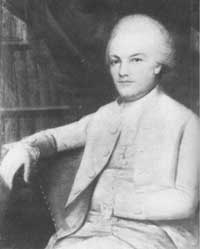







Biographical Sketches
|
CHARLES PINCKNEY South Carolina |
 Charles Pinckney | |
| ||
Charles Pinckney, the second cousin of fellow-signer Charles Cotesworth Pinckney, was born at Charleston, S.C., in 1757. His father, Col. Charles Pinckney, was a rich lawyer and planter, who on his death in 1782 was to bequeath Snee Farm, a country estate outside the city, to his son Charles. The latter apparently received all his education in the city of his birth, and he started to practice law there in 1779.
About that time, well after the War for Independence had begun, though his father demonstrated ambivalence about the Revolution, young Pinckney enlisted in the militia, became a lieutenant and served at the siege of Savannah (September-October 1779). When Charleston fell to the British the next year, the youth was captured and remained a prisoner until June 1781.
Meantime, Pinckney had begun a political career, serving in the Continental Congress (1777-78 and 1784-87) and in the State legislature (1779-80, 1786-89, and 1792-96). A nationalist, he worked hard in Congress to insure that the United States would receive navigation rights to the Mississippi and to strengthen congressional power.
Pinckney's role in the Constitutional Convention is controversial. Although he was the second youngest delegate, he later claimed to have been the most influential one and contended he had submitted a draft that was the basis of the final Constitution. Most historians have rejected this assertion. They do, however recognize that he ranked among the leaders. He attended full time, spoke often and effectively, and contributed immensely to the final draft and to the resolution of problems that arose during the debates. He also worked for ratification in South Carolina (1788). That same year, he married Mary Eleanor Laurens, daughter of a wealthy and politically powerful South Carolina merchant; she was to bear at least three children.
Subsequently, Pinckney's career blossomed. From 1789 to 1792 he held the governorship of South Carolina, and in 1790 chaired the State constitutional convention. During this period, he became associated with the Federalist Party, in which he and his cousin Charles Cotesworth Pinckney were leaders. But, with the passage of time, the former's views began to change. In 1795 he attacked the Federalist-backed Jay's Treaty, and increasingly began to cast his lot with Carolina back-country Democratic-Republicans against his own eastern aristocracy. In 1796 he became Governor once again, and 1798 his Democratic-Republican supporters helped him win a seat in the U.S. Senate. There, he bitterly opposed his former party, and in the Presidential election of 1800 served as Thomas Jefferson's campaign manager in South Carolina.
The victorious Jefferson appointed Pinckney as Minister to Spain (1801-5), in which capacity he struggled valiantly but unsuccessfully to win cession of the Floridas to the United States and facilitated Spanish acquiescence in the transfer of Louisiana from France to the United States in 1803.
Upon completion of his diplomatic mission, his ideas moving ever closer to democracy, Pinckney headed back to Charleston and to leadership of the State Democratic-Republican Party. He sat in the legislature in 1805-6 and then was again elected as Governor (1806-8). In this position, he favored legislative reapportionment, giving better representation to back-country districts, and advocated universal white manhood suffrage. He served again in the legislature from 1810 to 1814, and then temporarily withdrew from politics. In 1818 he won election to the U.S. House of Representatives, where he fought against the Missouri Compromise.
In 1821, Pinckney's health beginning to fail, he retired for the last time from politics. He died in 1824, just 3 days after his 67th birthday. He was laid to rest in Charleston at St. Philip's Episcopal Churchyard.
Drawing: Oil (ca. 1786) attributed to Gilbert Stuart. American Scenic and Historical Preservation Society.
 |
 |
http://www.cr.nps.gov/history/online_books/constitution/bio31.htm
Last Updated: 29-Jul-2004